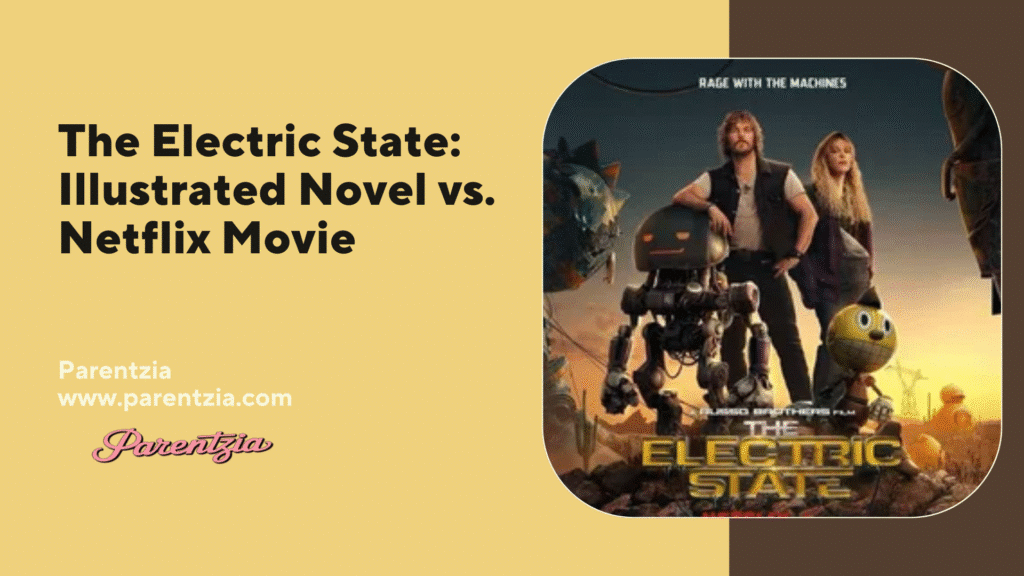Ever find yourself drawn more to the whisper of a story than the roar of its spectacle? Welcome to The Electric State—a tale reimagined in vivid contrast between Simon Stålenhag’s illustrated novel and its Netflix movie adaptation. This blog post digs deep and goes wide: we’re talking haunting art, dystopian sci-fi weight, the cultural pulse underneath, and why one version hums while the other sputters.
Simon Stålenhag’s The Electric State Book: Quiet Dread in Imagery
Simon Stålenhag quietly rewired the art world with The Electric State book. He blends dystopian sci-fi with nostalgia, setting it in an alternate 1990s, where abandoned technology and a post-industrial society cast a long, melancholic shadow.
you might also like “Good Morning Friday Blessings”
Setting & Narrative
- Where and when: A ravaged, hyper-commercial Pacifica (California), years after a devastating drone war. The land is littered with ruined drones and VR headsets—the result of weaponized tech gone consumer-grade.
- Main characters: Michelle—a teenager orphaned by war—and Skip, her robot companion, who strolls by her side as she ventures west to find her brother
- Neurocasters: Brain-computer VR devices that plunge people into endless hallucinations. Society becomes zombified, addicted, while infrastructure fails
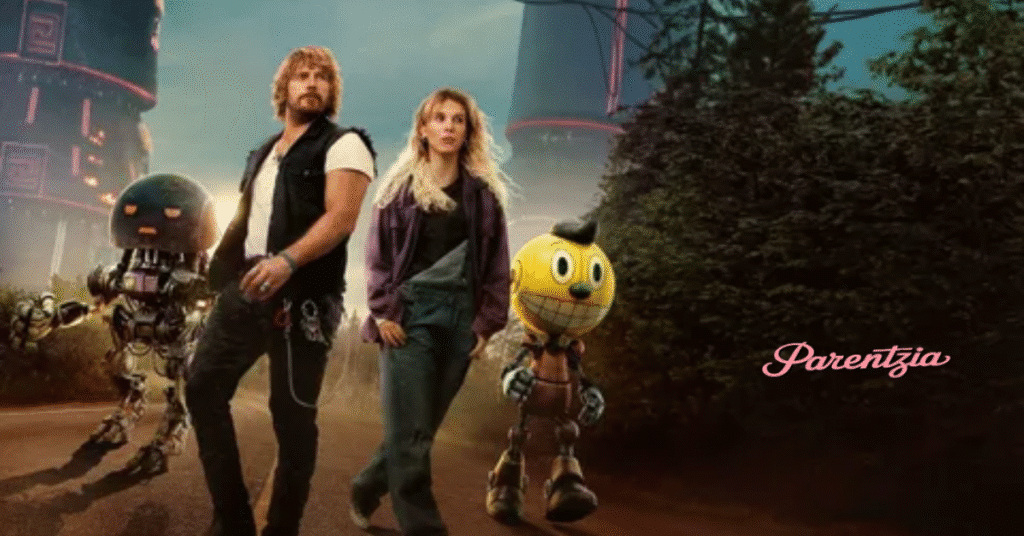
Themes That Hit Hard
- Digital dependency: The Neurocasters symbolize the addiction path from military tech to endless consumer escapism.
- Grief, identity, isolation: Michelle’s personal loss mirrors a broken nation. The voice is quiet but resonates.
- Queerness and religion: The novel nudges at Michelle’s sexuality, religious backlash, and how they shape adolescence in a collapsing world.
“It is in an extremely American story… families separated… intersection of war and technology; fire-and-brimstone religion and its effect on LGBT youth.”
Visual Storytelling Speaks
This is visual storytelling at its finest. Stålenhag paints silent roads, drifting fog, and decaying landmarks that say more than paragraphs ever could. NPR praised it as “photorealistic, washed out, laced in neon or icicles.”
His work doesn’t tell—it invites. Michelle’s road trip unfolds through melancholic remnants: a hulking mech in the haze, towers that feel like lighthouses in the void.
Real Recognition
This illustrated novel didn’t just survive—it thrived. It earned starred praise from Booklist and Publishers Weekly, and NPR named it one of the best books of 2018.
A fan put it simply: “Bleak, depressing, beautiful, heartbreaking… I wanted to sit there thinking about what it all meant.”
(Okay, I cleaned it up a bit—but you get that resonance.)
The Electric State Movie (2025): Blockbuster Flick with an Empty Core
Flip the page—or press play—and the tone changes fast.
Production & Scope
- Directed by: Anthony & Joe Russo
- Budget: A jaw-dropping $320 million—Netflix’s most expensive film, and among the top 15 most costly ever made
- Cast: Millie Bobby Brown, Chris Pratt, Ke Huy Quan, Stanley Tucci, Giancarlo Esposito; voice cameos from Harrelson, Mackie, Cox, and more.
- Music: Score by Alan Silvestri, tying back to his Marvel roots with the Russos.
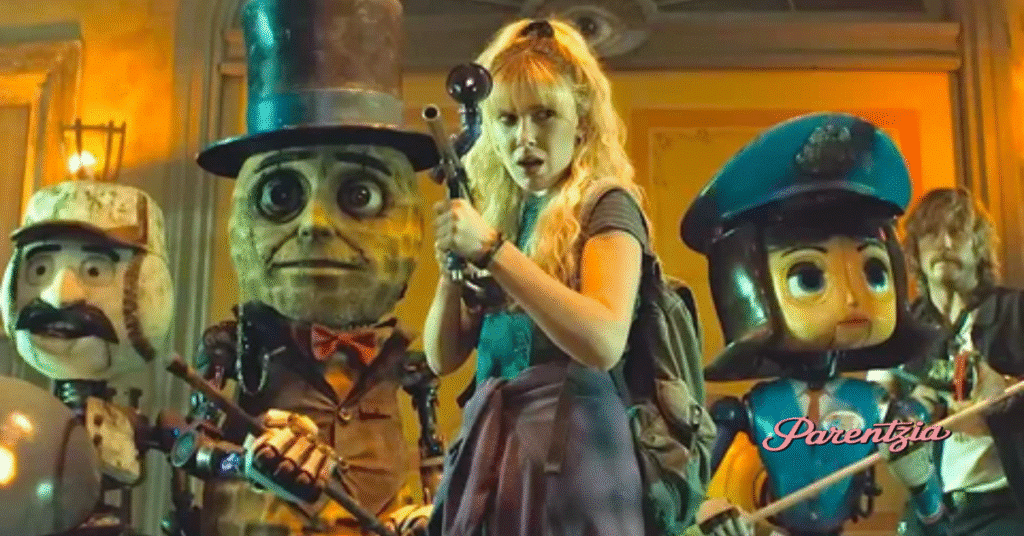
Plot: Same Bones, New Form
- Core setup: Michelle still travels west, paired with her robot (now named Cosmo), aiming to rescue her genius brother trapped in Sentre’s VR network
- Added action: Enter Keats, a smuggler. The road trip becomes a full-blown mission, complete with animatronic allies and robot-hunting.
- Neurocaster subplot: Reduced, moved to the background. No hive mind, no lingering questions—just spectacle
Visuals & Tone Clash
The retro-futurism is still there, but it glows artificially under CGI polish. Robots resemble theme-park mascots rather than broken relics.
Instead of eerie desolation, we get snappy banter, jokes, and blockbuster signals.
It feels less like a dystopian sci-fi fable and more like an expensive diversion.
Booker vs. Blockbuster: A Side-by-Side Contrast
| Aspect | The Electric State Book | The Electric State Movie |
| Tone | Quiet, haunting, introspective | Loud, flashy, comedic with action |
| Themes | Grief, addiction, isolation, identity, decay | Rescue, conflict, surface-level redemption |
| Visual Style | Hand-painted, dystopian, melancholic | CGI, polished, bright, toy-like robots |
| Protagonist Depth | Complex, introspective, emotionally raw | Simplified, archetypal road-movie lead |
| Critical Reception | Critically acclaimed, praised for visuals & depth | Rotten Tomatoes: 14%, critics call it soulless |
| Budget | Modest (relative), art-focused | $320M blockbuster (Netflix’s costliest ever) |
Reaction: Praise vs. Backlash
The Electric State book earned love for:
- Its emotional weight and minimalist beauty
- How it captures a post-apocalyptic alternate 1990s across surreal landscapes
- That uncanny intersection of AI and humanity and visual storytelling
The Electric State movie tripped badly:
- The Guardian calls it “soul-less and emotionally lacking”.
- New York Post rails at wasted budget, derivative plot, poor humor
- AP says even good effects can’t save its bloated story.
- Rotten Tomatoes reports just 14% positive reviews.
- Reddit murmurs: Netflix delivered “mega-budget slop.”
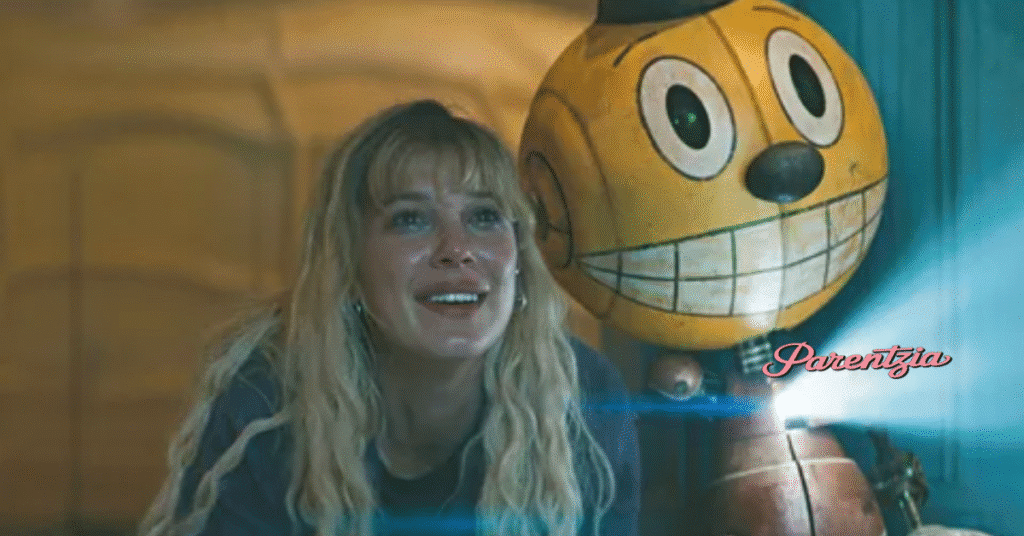
One critic summarized:
“It has all the ingredients for a sumptuous cinematic buffet—but ends up bland and boring.”
What the Two Versions Tell Us
On Adaptation
This is a masterclass in how adaptation can go wrong. You start with a slim, tender piece rooted in mood and subtext—and you overload it with shiny bots and chases. The soul gets overwhelmed.
On Visual vs. Emotional Storytelling
- The book trusts silence, invites reflection, and uses visual storytelling as a voice.
- The movie replaces that trust with spectacle, assuming gloss equals meaning—which rarely holds up.
On Cultural Commentary
Stålenhag is warning us about dehumanization, addiction, and decay in alternate history fiction. The film shrugs, aiming instead for broad audience appeal, diluting its message.
Final Thoughts: Which One Speaks to You?
- If you want quiet, thoughtful, emotionally resonant art—pick up the book. The illustrations and lingering mood stay with you.
- If you crave blockbusters, big action, and fast-paced rescue journeys—the movie is your ride, though critics warn it may leave you cold.
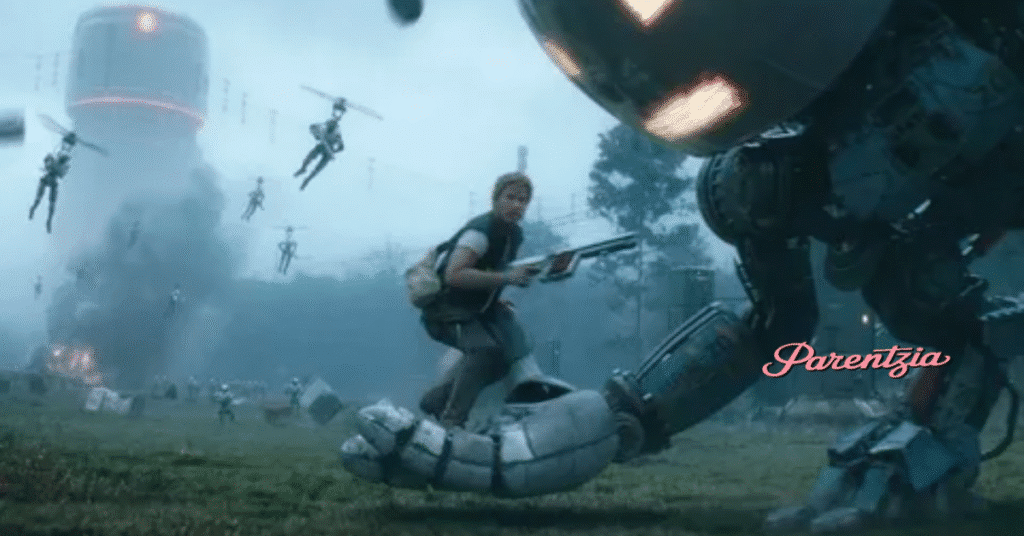
Recommendation Snapshot
- Read the book first. Let yourself sit in its silences and feel the world.
- Watch the movie after. Consider it a loose remix—spectacle over substance, with its own (flashing) flavor.
Conclusion
The Electric State reminds us: adaptation is more than copying a plot. When Hollywood traded Stålenhag’s soulful desolation for CGI, jokes, and blockbuster beats—it lost what made the story matter. Sometimes the quiet stories linger longest

Tina Grey is an experienced blogger with a passion for uncovering the best in film. With years of writing and a keen eye for detail, Tina brings insightful reviews and engaging content to Parentzia. Her deep love for movies, combined with her expertise, helps readers discover must-watch films across genres. When she’s not reviewing, Tina enjoys exploring new cinematic trends and sharing her love of film with her audience.

